

Cuba Travel Guide
Your ultimate cuba travel guide, with tips, things to do, and best things to see in cuba. great for first-time and returning travelers..
Located on the largest island of the Caribbean, Cuba is a very popular tourist destination and for good reason.
Cuba is home to beautiful white-sand beaches, impressive rainforests and waterfalls, vibrant culture, and lively cities .
Due to various trade restrictions over the years, Cuba has many described by many as like walking into a time capsule and is now a unique blend of the past and present, where vintage cars roam around colorful historic buildings and towns.
The birthplace of salsa music, Cuba is also full of rhythm. Add in its sub-tropical climate, and it is a great place to vacation.
This Cuba travel guide will help you plan your next vacation.
Popular Guides
- Things to do in Havana
- Cuba Photos
Our Highlight
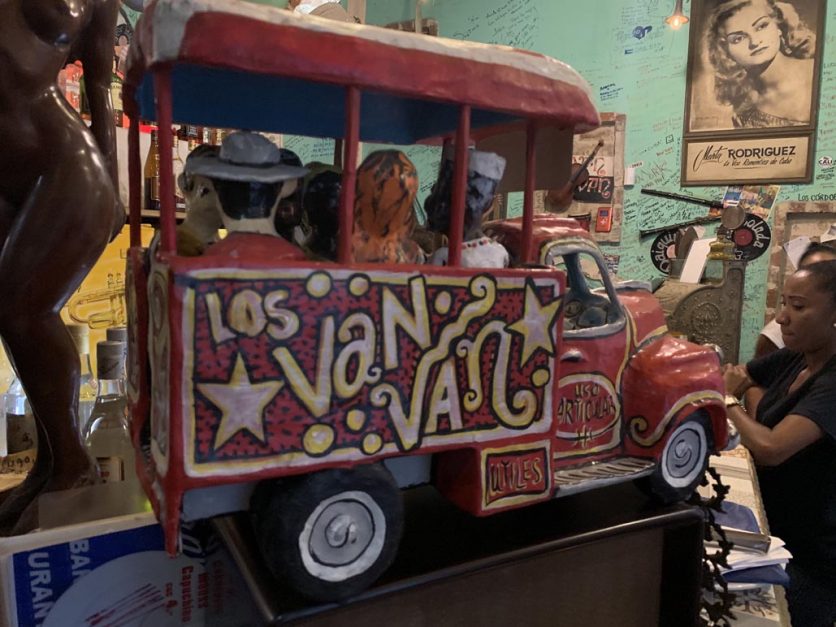
Table of contents
Table of Contents
Fast Facts about Havana
- Power voltage is 110V-220V at 60 Hz. Type A, B, C, and L.
- Cuba’s two currencies are the Cuban Peso and the Cuban Convertible Peso, mainly used for tourists.
- 1 Cuban Convertible Peso is equal to 1 USD.
- The best way to get around Cuba is by bus or taxi. If taking a taxi, make sure the taxi is licensed before riding.
- You need a tourist card to enter Cuba, as well as a passport that is valid for two months after your trip ends. The tourist card allows you to stay in Cuba for up to 30 days.
- The most popular cellular networks in Cuba are Cubacel and Digicel and both offer SIM cards. It should be noted the SIM cards can only be used on unlocked GMS phones. To rent a SIM card, you need a passport and your IMEI (phone ID) number.
- Cuba has a sales tax rate of 2% on wholesale sales and a 10% rate on both retail sales and services.
- SIM Cards : Cuba has very limited Internet and the best bet for visiting Cuba is to unplug, relax and if you have to, use your hotel’s limited WiFi for emergencies.
- It is advisable to download offline maps and any apps offline that you use to travel.
Things to See and Do in Cuba
- Hike Through Sierra Maestra: Cuba’s largest mountain range and the start point of the Cuban Revolution. Take a tour to learn more about Cuba’s history and enjoy a beautiful hike and great mountain views.
- Varadero Beach: Visit this pristine and popular beach in Sol Palmeras. Walk through the sand, swim in the clear waters, get to know other tourists or locals, or simply relax and take in the beautiful views.
- Old Havana: Old Havana is the city center of Havana is considered a crucial part of any trip to Cuba. Stroll through one-of-a-kind historic streets and buildings to see the history of Cuba.
- Tropicana Club: Head to the famous Tropicana Club for some great nightlife entertainment. Get dinner and enjoy the thrilling cabaret show that’s been running since the 1930s, featuring lively song and dance numbers.
Cuba Travel Guides
- 36 Fantastic Things to do in Havana, Cuba
Accommodation
Budget: Cuba offers family-run bed and breakfasts (or casas particulares) for around 15 to 25 pesos per night.
Mid-Range: For mid-range hotels, expect to pay roughly 70-130 pesos per night.
High-End: Upscale hotels will cost about 150-250 pesos per night.
Check out our favorite booking platforms Booking.com , Tripadvisor and VRBO for the best deals on accommodation.
If you’re on a budget, you can find options for pizza or spaghetti at around 3-4 pesos each.
Coffee lovers can find delicious cups of coffee for around 0.10 pesos. Restaurants are a good way to learn more about Cuban cuisine.
Expect to pay around 10-15 pesos for a meal at a restaurant.
The Best Ways to Get Around Cuba
Getting to cuba:.
Getting to Cuba: While there are 10 international airports in Cuba, the Aeropuerto Internacional José Martí in Havana is the main one, with the Gualberto Gómez International Airport in Varadero being a close second.
Flights: You can check for the best flights to Cuba on Skyscanner .
Transportation:
Transportation: Look for the Viazul buses, which are made especially for tourists and feature air-conditioning. Great for long distances, you can travel from Trinidad to Havana in six hours for just 25 pesos.
You will want to arrive at the station in advance to get a spot.
Trains : The train system in Cuba runs the length of the island and is a good way to meet the locals.
Go from Havana to Santa Clara for just 20 pesos, or from Santa Clara to Santiago de Cuba for 50 pesos. Be advised that the trains only run every few days, so planning ahead is key.
Taxis: Taxis are an alternative way to get around Cuba.
Fares start at 1 peso as a flat rate and increase by 1 peso for each kilometer traveled.
To travel from Old Havana to Miramar, for example, costs 8 to 12 pesos.
Car Rental: It is possible to rent a car in Cuba, but it is expensive and can be convoluted. Take care when you do. Check rates and availability here.
When to go To Cuba
Between November and April is the most popular time to go to Cuba, as temperatures range from 78 to 85 degrees Fahrenheit and skies tend to be blue.
You can find higher temperatures (up to 90 degrees) and lower hotel rates in August but note that hurricane season is between August through October.
Where to Stay in Cuba
Iberostar Grand Packard – Located on the Malecon and walking distance to Old Havana, this is the premier place to stay in Cuba.
Hostal Las Palmas :One of the most highly rated bed and breakfasts in Trinidad. Explore Trinidad and the Playa Ancon beach, which are both close by.
Suite Florencia : Built-in 1940, this colonial house turned hotel in Santa Clara is right in the middle of everything. Descend the white marble staircase into this romantic hotel.
Enjoy beautiful views of Santa Clara from your room, or roam about Santa Clara and visit the nearby restaurants and bars.
What to Pack for Cuba
Cuba has a tropical climate so you can count on it being hot and humid.
- Swimsuit: With Cuba”>
- Sunscreen: Protect your skin from the powerful sun with some sunscreen.
- Cash: As you may not be able to withdraw money from your bank accounts while in Cuba, make sure to bring an appropriate amount of cash based on what you think you’ll spend.
- We didn’t have a problem withdrawing from ATMs in Havana, but it is better to be safe
Cuba Travel Guide: Best Booking Resources
Whenever we travel to we make sure to start with these companies. We have tried a lot of different ones over the years and all of these have consistently proven to be the best when it comes to offering great prices.
We have used every one of these personally and continue to do so.
- Booking.com : This is our go site to when comparing prices for accommodation. It usually has the cheapest prices, especially in Europe and we love their interface. Not to mention you get free cancellation and you are guaranteed the best price.
- Trip Advisor : What we like about Trip Advisor is that we can look at all the reviews and then book our accommodation. TripAdvisor is where we go when we want to compare prices with multiple accommodation providers.
- VRBO : is the main search engine we use when we are looking for a home or apartment rental. It can sometimes be cheaper than hotels and it is the best way to stay in areas that offer a more local feel.
- Hostelworld : With one of the largest databases of hostels in the world, Hostelworld is the go-to site when you are looking for budget accommodation.
- Skyscanner : This is the first place we check for flights. It consistently comes back with the cheapest and best options. It allows us to compare a lot of airlines to get the best price.
- Rome 2 Rio : If you want to see how to get somewhere by plane, train, bus, ferry or car Rome2Rio lays it all out for you as well as related costs.I love how they show it all to you on a Google Map and it works offline.
- Get Your Guide: For all your day trip and city guide needs, we use Get Your Guide. It has the world’s largest collection of things to do with more than 30,000 activities in 7500 destinations.
- World Nomads Insurance: When traveling to Italy you should always have travel insurance. We have found the best bang for your buck is by far World Nomads.
Cuba Travel Guide: Related Articles
To browse all our articles and guides about Cuba Click Here.
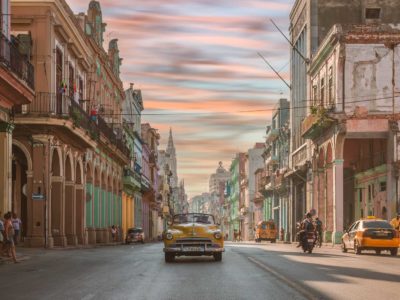
19 Unforgettable Places to Visit In Cuba in 2024
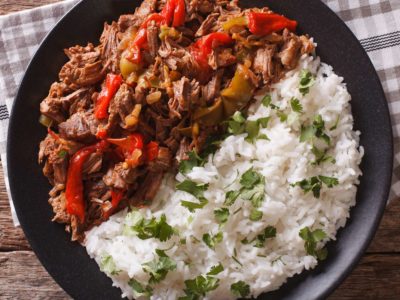
Cuban Food: 23 Cuban Dishes You Can Try at Home
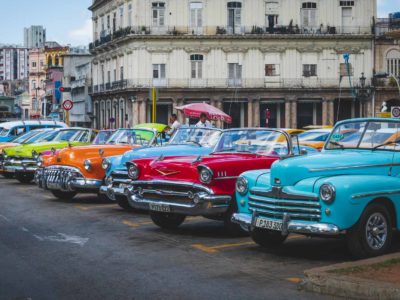
19 Fun Facts About Cuba You Never Knew
Choose your language
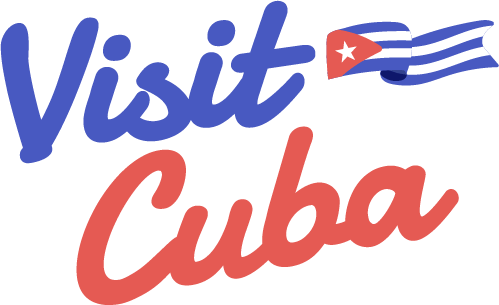
Welcome to Cuba
More than you imagined
Plan your holiday to Cuba
Cuba Up-Close
Six Essential Tips for Your Trip to Cuba 2022
From alternative accommodation to bypassing the restrictive internet in Cuba, check out these six essential tips for your trip to Cuba.
Cuba up-close
When is the best time to visit Cuba?
Planning a visit to Cuba? The island offers sunny skies and activities year-round. Learn more about its seasons, weather, and cultural calendar.
Is it safe to travel to Cuba?
Here are some of the best safety tips to follow as you enjoy your trip, and use public transportation in Cuba.
Greatest Waterfalls in Cuba
Imagine finding yourself in Cuba, surrounded by an exuberant natural environment - where the vivacious green mountains stretch out into a splendid blue sky - while the fresh Caribbean seabreeze brightens your face. And on this tropical voyage, you discover a land of waterfalls on every corner of the island.
El Nicho waterfall, Sierra de Escambray
Photo: Shutterstock
Looking for some cool things to do?
The landscape of cuba: topes de collantes.
Enter and Explore Topes de Collantes. Home to amazing waterfalls
The Top Five Best Bakeries in Havana
Sweeten-up your life with some of the most exquisite pastries
Explore Varahicacos Reserve in Varadero
Indulge in the landscape of Cuba at Varahicacos Ecological Reserve,
Lesser Known Parts of Cuba to Discover This Year
Escape the crowds and Look further into the Cuban landscape
Fábrica de Arte Cubano: A Unique Experience for Art Lovers
Havana houses one of Time Magazine’s Best 100 experiences: the
Where to Drink in Havana: Our Essential List of the Best Bars
Explore our essential list of the best bars in Cuba,
Five Cuban Clothing Brands to Shop for in Havana
Take a look at the emerging Cuban dress wear brands
See Cuban Nature Up-close at Sierra Del Rosario
Reconnect with nature at Cuba's Sierra del Rosario nature reserve.
Best Spots for Fishing Around Cuba
Largely untouched and diverse, Cuba is one of the most
Top Four Jazz Clubs in Havana
Things to DoTop Four Jazz Clubs in Havana La Zorra
Cuba’s capital has always enjoyed a lively jazz scene, and has produced legendary musicians. It’s time to visit Havana’s best jazz clubs!
La Zorra Y El Cuervo jazz club, Vedado, Havana
Photo: Alamy
Winter activities and tips!
History & Heritage
Visit the Museo de la Revolución
Wildlife & Nature
Ciénaga de Zapata
Castillo del Morro
Beaches & Islands
Hit the Beach at Tarará
Tarará Beach – Havana’s Best Kept Secret
Tired of typical tourist spots? Get to know Tarará beach,
Castillo del Morro: A Historical Fortress in Havana
Learn about the History of Cuba in the bay of
Ciénaga de Zapata: A Natural Cuban Treasure
Encounter the endemic flora and fauna of Matanzas Cuba, and
Visit the Museo de la Revolución, and Relive the Fight for Cuba
Havana’s Museo de la Revolución offers a thorough look at
The Cuban Cigar: Everything You’ll need to know
Learn about the curious and mysterious history of the Cuban cigar, how a Habano is made, and where you can buy quality tobacco like Cohiba cigars.
A Cuban woman with a cigar, Havana
Check Us out on Instagram
@govisitcuba, subscribe to our newsletter.
Get more travel inspiration, tips and exclusive offers sent straight to your inbox
I would like to get Visit Cuba newsletters in my inbox
Paradise for Your Inbox
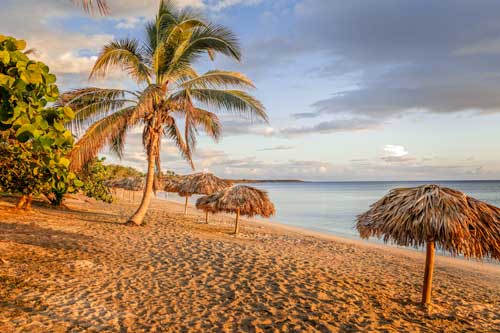
- Destinations
20 things to know before visiting Cuba

Jan 5, 2024 • 8 min read
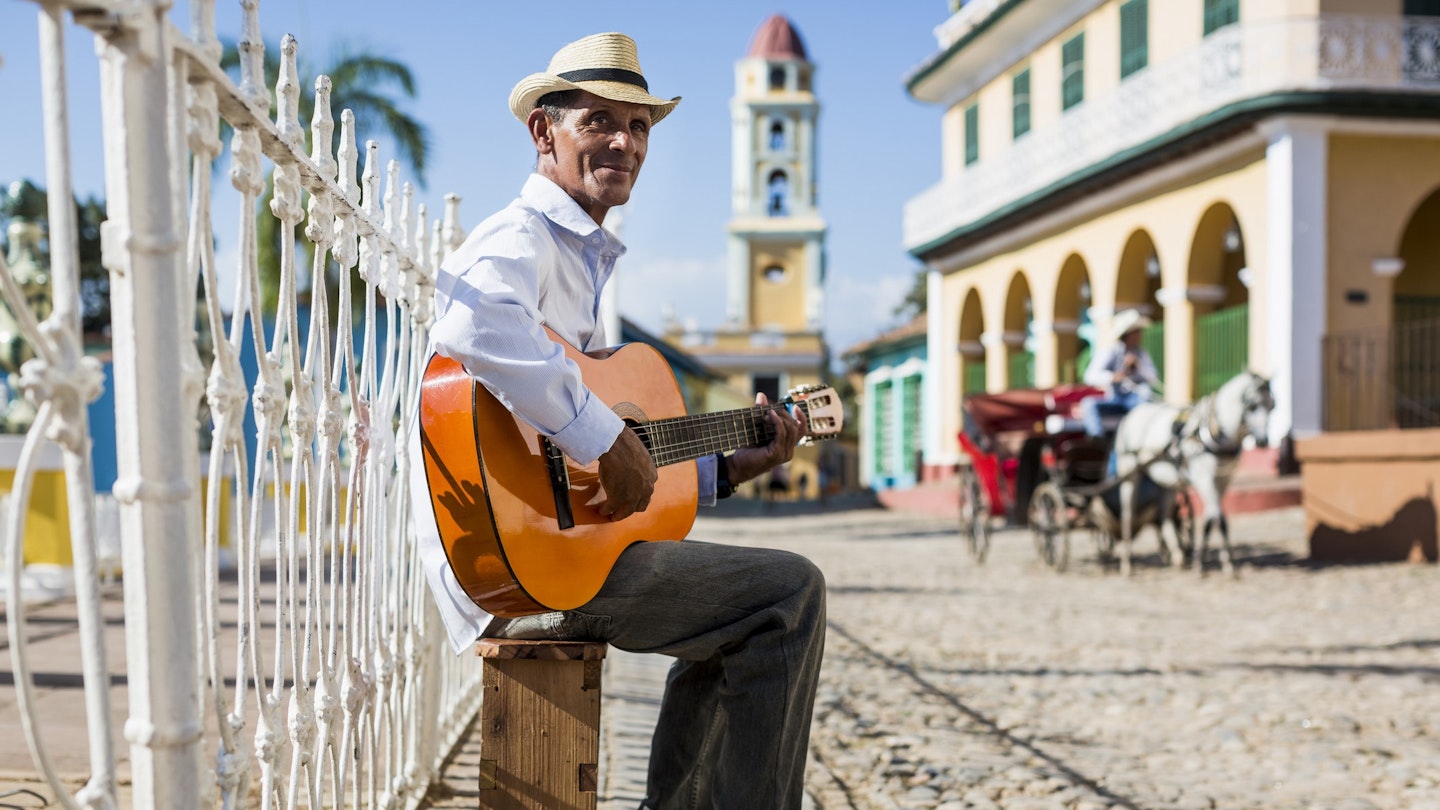
Be ready for your visit to Cuba with these top tips on what to expect © Westend61 / Getty Images
To a first-time traveler, Cuba can seem like a confusing jigsaw puzzle, particularly if you’re breaking free of the resorts and traveling around on your own.
The Spanish spoken here is fast and hard to decipher, many streets have two different names and the country’s fickle and highly complicated monetary situation could fill its own guidebook.
To help you be prepared, here is everything you need to know before planning a trip to Cuba.
1. Double-check your insurance
You are required to have medical insurance to visit Cuba and will need to bring digital or printed proof of your policy. Random checks are made at the airport. If you arrive without insurance, you’ll be asked to buy a Cuban policy at the airport for US$30.
2. Fill out your passenger information in advance
Cuba uses an online form called D’Viajeros to gather traveler information, including immigration and health data, in advance of travel. Fill out the form digitally up to 72 hours before your arrival in Cuba.
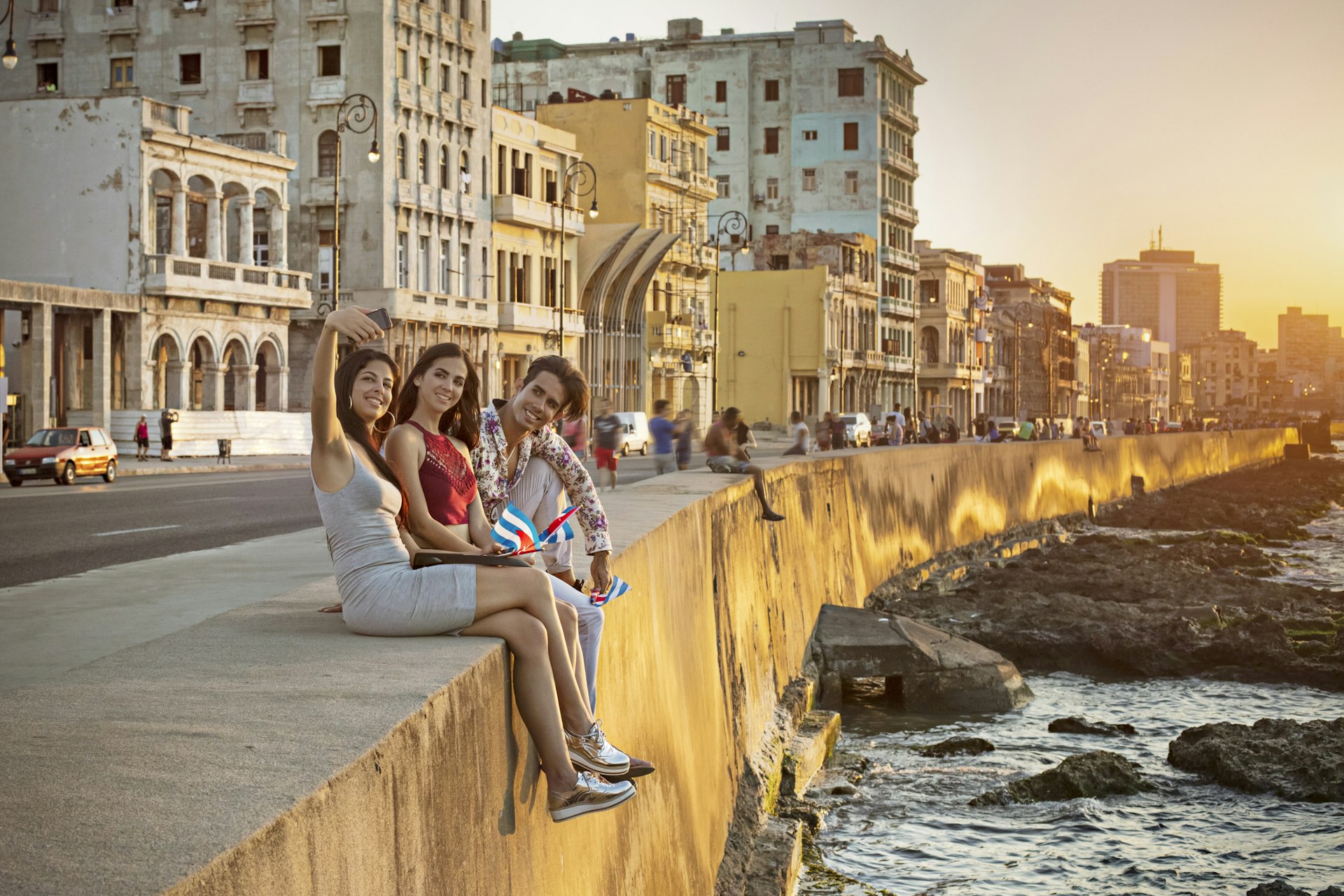
3. Every visitor needs a tourist card
To enter Cuba, all visitors need to present a completed tourist card . It’s usually available through your airline (ask when booking) and included in the price of your ticket.
If not, you can purchase one through a Cuban travel agency. Costs range from US$50 to US$85. Citizens of 20 African and Asian countries require a formal visa to enter Cuba. Check the situation for your country before booking.
4. Cash and currency: it’s complicated!
Money in Cuba is confusing, even to Cubans . Since the country abolished convertibles (CUC) in January 2021 and took the US dollar out of circulation in June 2021, there has been massive inflation and the emergence of a rampant black market. The knock-on effect is a bewildering dual economy.
The official currency of Cuba is the Cuban peso (CUP), but foreign currencies are also widely accepted, especially by private businesses who need hard cash to buy non-rationed goods in MLC (freely convertible currency) shops.
State-run enterprises and banks use official exchange rates. However, the prices of the superior services offered by private businesses generally reflect black market exchange rates.
Hence a main dish in a private restaurant in Havana will cost around CUP$500 (US$21). That’s an expensive meal if you’re paying in pesos bought from a Cuban bank.
However, most private restaurants will also accept payment in euros using a more favorable exchange rate. Some will even have a separate menu with prices printed in euros.
When buying something from a private business – be it a restaurant, casa particular (private accommodation) or taxi service – it’s usually best to pay in a foreign currency. Always ask upfront what currencies they accept and what exchange rate they use for their published peso prices.
Euros is the most interchangeable currency and the one preferred by Cubans. You can also use and exchange Canadian dollars and pound sterling.
US dollars still circulate on the black market, but we don’t recommend bringing them. The best bet, when you arrive, is to keep most of your money in a foreign currency and only change small amounts into pesos for incidentals like museum entry, concert tickets and tips.
5. MLC is a currency with no cash form
The Moneda Libremente Convertible (MLC) is a currency approved by the Cuban government in 2020 that can be used in certain shops to buy higher-end goods.
The currency doesn’t exist as cash and its value is pegged with the US dollar. It’s used mainly by Cubans with special magnetic cards.
Tourists needn’t worry too much about MLC$, although prices will sometimes be displayed in the currency in state-run enterprises such as cigar shops or airport souvenir stores where you can pay with a non-US credit card.
6. Only some credit cards will work
Credit cards are increasingly popular in Cuba and in many state-run businesses are the preferred (and sometimes only) method of payment.
Despite promises made in the Obama era, credit cards linked to US banks are not accepted. Private businesses almost never have credit card machines, meaning your only option is cash.

7. Pack your favorite casual clothes – and men need a shirt
Dress in Cuba is casual, so you can leave your high heels and tux behind. The only real dress code is in cinemas, theaters and nightclubs, where male patrons are required to wear long trousers and shirts with sleeves or half-sleeves.
8. Cuban Spanish is fast and often informal
If you speak Spanish, you’ll find that Cubans mostly use the informal tú form of address, rather than usted . In the plural, ustedes is used over vosotros .
If you don’t know someone, it’s best to address them as señor or señora , though you’ll hear Cubans use all kinds of substitutes such as socio , hermano , papa , chica/o and asere .
9. Cuban cities are where the streets have two names
In most Cuban cities, the streets have two names: a contemporary one that is noted on maps and marked on street signs, and a pre-revolutionary one that is still used widely by the locals.
This can become confusing, especially when locals, unaware of the new street names, start giving out directions or addresses using the colloquial nomenclature. Always double-check addresses and, if possible, get two potential names for the street you’re looking for.
10. Understand the local art of queueing
Cubans have to endure a lot of long waits in boring queues, so they’ve invented a way of doing it that doesn’t involve standing in line. In a Cuban queue, you simply roll up at the bakery/clinic/visa office and yell out to the assembled masses, "Quien es último?" (Who’s last?).
Hopefully, someone in a 400m vicinity will answer your polite entreaty with the word, "yo" (me). That person is your yardstick. As long as they’re still around, feel free to go for a walk, sit in the lotus position or buy ice cream. When they get called up, be on your toes, you’re next!
11. Ask questions more than once
Thanks to heavy bureaucracy, answers to simple requests aren’t always straightforward – or even correct. Probe politely and ask at least five different people before you make important decisions.
12. Bring something to keep you warm on a cold bus journey
Cuba has a countrywide state-run bus service called Víazul that connects all of the main cities and some of the smaller towns. Prices are charged in MLC$ (the same rate as the US$) and tickets must be paid for with a credit card either in person or online.
A second service called Conectando, run by Cubanacán, also puts on buses in peak season along some of the more popular routes. Bring a sweater/jacket for long bus rides – the air-conditioning is akin to a chilly day in Vancouver.

13. Cuba is considered a safe place to travel
Cuba is one of the safest countries in the Americas in terms of violent crime. Pick-pocketing is more common but not rampant, and is mostly avoidable if you follow a few basic precautions: Wear a money belt, use safe boxes in hotel rooms and don’t flash your cash in public.
14. Solo female travelers report receiving unwanted attention
Solo female travelers report experiencing a good deal of unwanted attention, but it didn't necessarily spoil their enjoyment of traveling in Cuba.
There is a fine line between being open and friendly and harassment, and some men can cross that line by being overly familiar or asking too many personal questions. Learn some key phrases in Spanish that make it clear when you're not interested.
15. Beware of forgeries
Never change money with unlicensed traders on the streets. You run the risk of receiving estafas (forged notes).
16. Bring your own medicines
On one level, Cuba has a good health system (it invented and quickly distributed three COVID-19 vaccines); on the other, it is perennially short of pharmaceuticals.
Bring all the prescription medications you think you’ll need, as well others you might like ibuprofen or paracetamol. If you’d like to donate some medicines to the people of Cuba, it is currently possible to bring in 10kg of medical supplies tax-free (pack them in a separate bag).
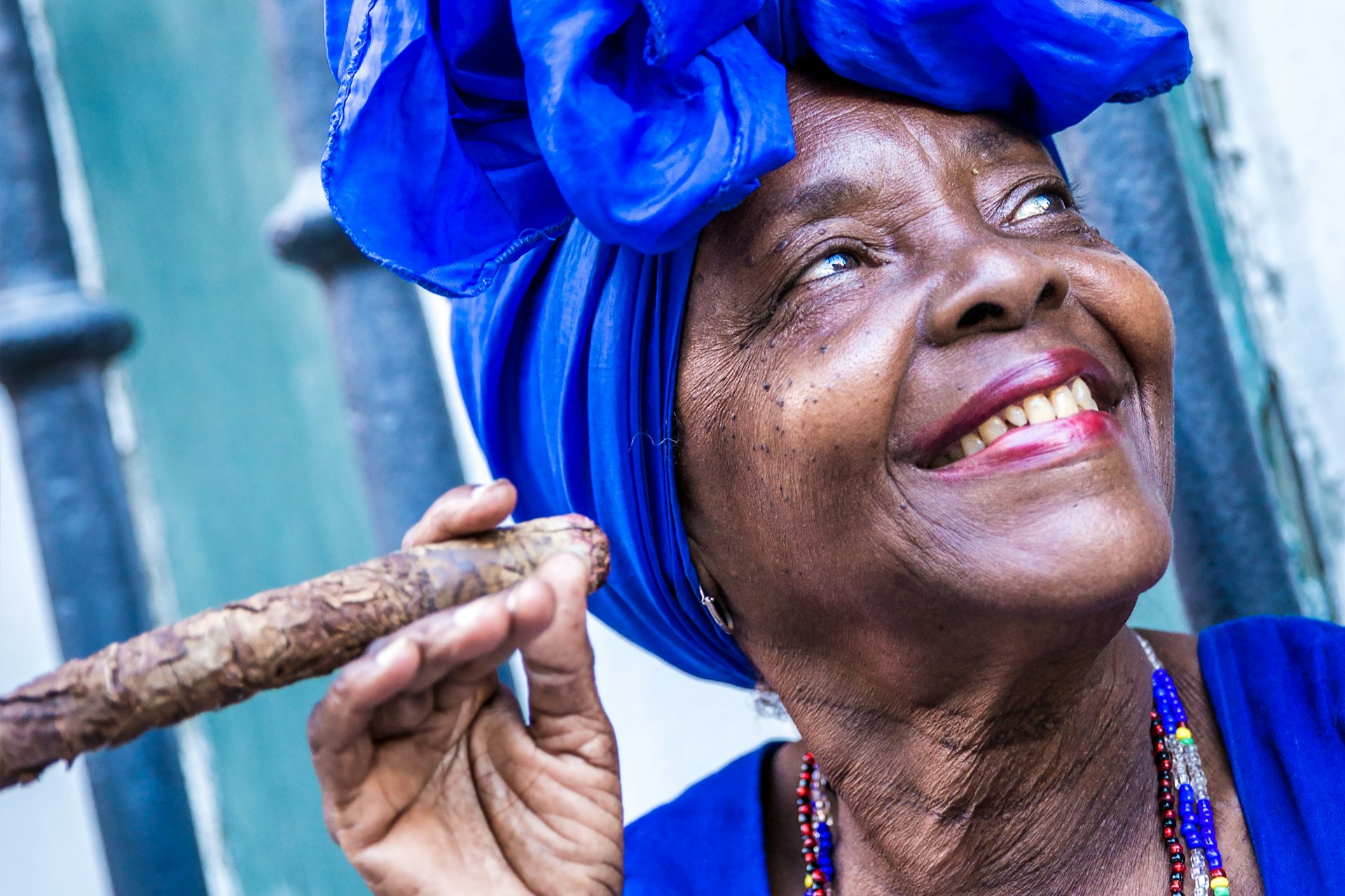
17. Avoid dodgy cigars
Cuba has its share of jineteros (touts) spinning elaborate stories about super-cheap, high-quality cigars procured by their brother/mother/cousin from the factory. Don’t believe them. Instead, buy your cigars in state-run shops such as the Casa del Habano chain. Cigars sold on the street are invariably factory cast-offs and not genuine.
18. Driving is not as easy as you think
With light traffic on the road, driving might seem like an easy proposition, but with elevated rental prices and cars often in short supply, it’s not always so.
Add in sporadic signposting, potholed roads and a wide array of hazards – goats, horses, bicycles, kids and slow-moving, fume-belching trucks – and you might want to consider getting the bus or, at least, employing the services of a chauffeur.
19. Bring toilet paper and sanitary products
The pandemic made the provision of antiseptic hand lotion more common, but the same can’t be said of toilet paper. Carry your own roll and/or gravitate to four- or five-star hotels when you’re caught short in the city.
Re-usable pads and silicon cups, or disposable pads and tampons are must-pack items if you're expecting your period while you're in Cuba. These are in high demand here.
20. Don’t drink the water
The water won’t kill you, but it might give you a little queasiness or an upset stomach. Fortunately, bottled water is abundant and cheap. An even better idea is to bring your own filter bottle or water purification tablets.
This article was first published February 2022 and updated January 2024
Explore related stories
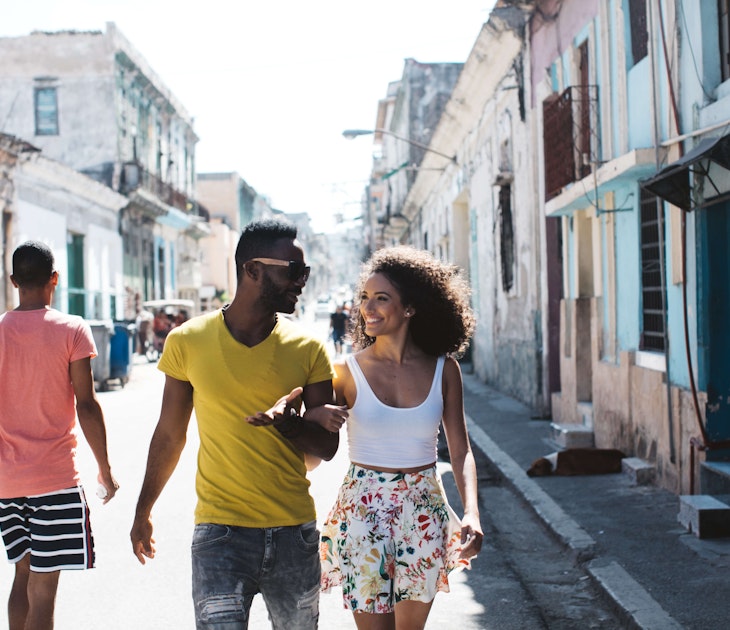
Tips & Advice
Jan 18, 2024 • 4 min read
Travelers often have questions about the visa process for Cuba and whether US citizens can even visit. Here’s our guide to Cuba’s visa requirements.
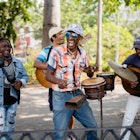
Jan 9, 2024 • 4 min read
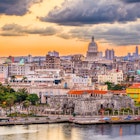
Jan 9, 2024 • 6 min read
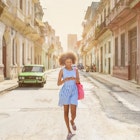
Jan 7, 2024 • 10 min read
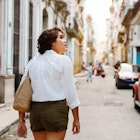
Jan 6, 2024 • 7 min read
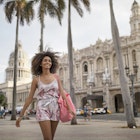
Jan 5, 2024 • 4 min read
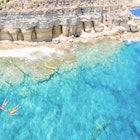
Nov 24, 2023 • 7 min read

May 6, 2023 • 9 min read

Jan 6, 2023 • 7 min read

Jan 5, 2023 • 8 min read

Ultimate Guide to Travel to Cuba (2024 Update)
Cuba is well known for its white sand beaches, delicious rum, and world-famous cigars… but you might be surprised learn just how much Cuba has to offer travelers. From incredible hiking destinations and wildlife preserves to fascinating historical sites and modern art galleries, Cuba is so much more than most visitors expect.
Unfortunately, there is a lot of confusion about who can travel to Cuba (hint: yes, Americans can travel to Cuba ! ) and how to travel to Cuba. Thankfully, Cuba travel is easy for just about anyone.
In this ultimate guide to travel to Cuba, we’re covering a ll the details about how to travel to Cuba, the best things to do in Cuba, and why you need to add Cuba to your travel bucket list .
Plus, keep reading for all the inside tips we’re sharing about what to pack for your trip, and what to leave at home.

This post contains affiliate links that may reward me monetarily or otherwise when you use them to make qualifying purchases – at no cost to you. As an Amazon Associate, I earn from qualifying purchases. For more information, please read our disclosure policy .
Cuba at a Glance
Who can travel to cuba.
Everyone can travel to Cuba! – even U.S. citizens or citizens of other countries traveling through the United States. U.S. citizens are required by the United States government to only spend money at private businesses (rather than government-run establishments) while there – which is quite easy to do.
Read More: Ultimate Guide to Travel to Cuba from the United States
Cuba uses the Cuban peso , valued at 24 pesos to $1 USD . However, since 2021 Cuba has been experiencing high inflation, and the official exchange rate is much lower than the one you’ll find if you exchange your money with a moneychanger.
Read More: Currency in Cuba: Ultimate Guide to Changing and Using the Cuban Peso
Spanish is the only language spoken in Cuba, with English occasionally spoken in the tourism industry . Download Google Translate before your trip to help. Check out our guide to the apps you’ll need for travel in Cuba for more recommendations.
Cuba is known for being an extremely safe country , much safer than most other places in Latin America or the Caribbean.
Take precautions that would generally when traveling – don’t be excessively flashy with jewelry, hold on to your stuff well in crowded areas, etc. You can find more Tips for Visiting Cuba like these from a fellow traveler here.
Electricity
Some areas of Cuba use 110V electricity while others use 220V electricity , and you’ll find a mix of plug types in different places around the island. We recommend bringing along a universal travel adapter and electrical converter so you can use your devices while there.
Internet in Cuba isn’t everywhere yet, but it is generally easy to access , although slower than you may be used to. We wrote a complete guide to using the internet in Cuba with all the details.
We recommend using a VPN (Virtual Private Network) when using the internet in Cuba. Check out our complete guide to using a VPN in Cuba for more details.

Required Insurance for Travelers
Cuba requires that all travelers show proof of travel insurance coverage upon arrival. We recommend Visitors Coverage for American and Canadian citizens and World Nomads for those of other nationalities.
Read More : Ultimate Guide to Cuba’s Travel Insurance Requirements
Our Most Popular Cuba Guides
- How to Legally Travel to Cuba from the United States (It’s Easy!)
- Ultimate Guide to Havana, Cuba
- Ultimate Guide to Varadero Beach, Cuba
- How to Get the Tourist Visa to Cuba
- Cuba’s Required Travel Insurance: What You Need and How to Get It
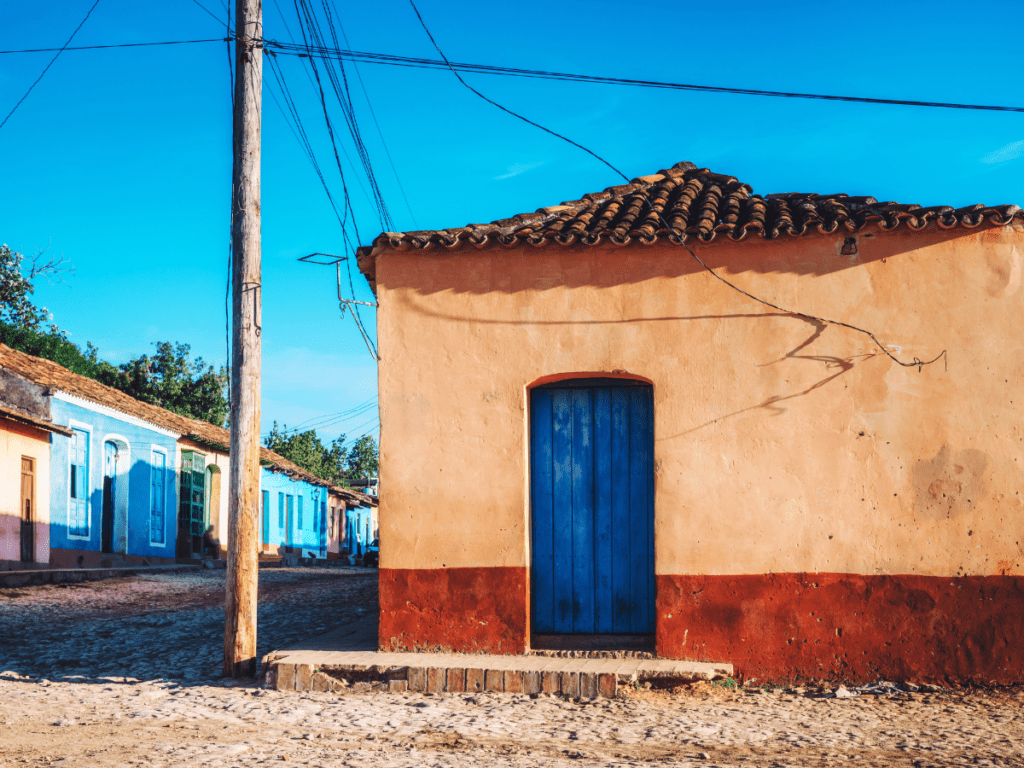
Weather in Cuba
A tropical country, Cuba has two seasons: the wet season and the dry season . The heat will generally dip slightly in the winter months (November through April) , but not much.
While the dry season generally attracts more tourists, the weather is perfect for a visit. May is a good time to visit as well, with the weather still nice and fewer tourists.
Dry Season: November – April
Wet Season: May – October
Don’t forget, Cuba occasionally experiences hurricanes . Peak hurricane season is from mid-August through mid-October.
Peak Tourist Season
Peak tourist season in Cuba lasts from early December through the end of March. Peak tourist season generally starts with a huge spike around the holiday season , when many Cubans living abroad come home to visit family.
Visiting around Christmas and New Year is when I’ve seen the greatest price increase in the price of flights and accommodations across the island – try to avoid these weeks if you can.
Best Things to Do in Cuba
Visit havana.
The craziest and most beautiful city in the world in our most humble opinion, Havana is like no other place on the planet.
Many say it’s stuck in the 1950s, but they couldn’t be more wrong – Havana holds on to its history beautifully while moving forward in a wholly modern way that will leave you enchanted.
Some of the best things to do in the city include exploring Old Havana , taking in the view over the city at the Cristo de la Habana , and ending the night with a drink and a show at the Fábrica de Arte Cubano .
Planning A Trip to Havana?
Check out our travel guides for insider information:
- Ultimate Travel Guide to Havana, Cuba
- Where to Stay in Havana
- The Best Airbnbs and Casa Particular Rentals in Old Havana
- The Best Airbnbs and Casa Particular Rentals in Vedado
- The Best Cafes in Havana and The Best Brunch in Havana
Visit Cuba’s Beaches
Cuba is known for having some of the world’s most beautiful beaches. Not only that, but many of them are as close to virgin, untouched beaches as you can still find in the Caribbean, which makes for an unmatched experience.
Check out our guide to the Top 10 Best Cuban Beaches to help you choose which to add to your itinerary.
The Beaches of Holguin
The province of Holguin is home to some of Cuba’s best beaches – Guardalavaca, Playa Pesquero, and Playa Esmeralda. Check out our ultimate guide to Holguin, Cuba for more details.
Varadero is the best-known beach in Cuba due to its proximity to Havana – it’s the perfect getaway from Havana for those looking to spend time in both the city and at the beach. If you’re picturing crystal clear waters and white sand , you’re thinking of Varadero.
While Varadero has a built-up infrastructure so you’ll have everything you’d want at your fingertips, there are also areas of Varadero where you can still get a slice of the beach all to yourself.
Read More: Ultimate Guide to Varadero, Cuba
Cayo Coco and Cayo Guillermo
This incredible pair of ‘cayos’ aka ‘keys’ located on the north shore of Cuba are served by their own international airport and have about a dozen large international hotel chains between them.
They’re some of the most underrated islands in the Caribbean .
If you’re looking for an all-inclusive beach experience, I recommend checking out these two keys and some of the incredible hotels they have to offer. The beaches here are truly pristine – some of the best beaches in Cuba .
Playa Ancón – Trinidad, Cuba
Playa Ancon is known as one of the most beautiful beaches on the southern part of the island, and is close to Trinidad, Cuba , an absolute colonial gem of a city that will take your breath away.
If you’re looking to get outside of Havana and Varadero track, which most travelers visit, we definitely recommend considering Trinidad and Playa Ancon!
Ride in A Classic American Car
The cars in Cuba are absolutely enchanting. While they’ve been kept on the road mostly out of necessity, it makes for a car-lover’s dream to see city streets packed with them.
A ride in a vintage convertible along Havana’s famous Malecón sea wall is a must while in Cuba.
Visit A Tobacco Farm in Viñales
Get up close and personal with one of Cuba’s most famous exports in Viñales , at the heart of the best tobacco-growing region in the country.
Here you can travel by horseback to beautiful tobacco farms where you’ll learn about how tobacco is grown, dried, and formed into world-famous cigars.
Viñales is also one of the most beautiful places in Cuba – this stunning valley is a UNESCO World Heritage Center . It’s an unforgettable way to see a stunning area of the country while this excursion!
What to Pack for Cuba
Check out our Ultimate Cuba Packing List to help you pack for your trip – we’re sharing exactly what to bring to Cuba and what we never travel without.
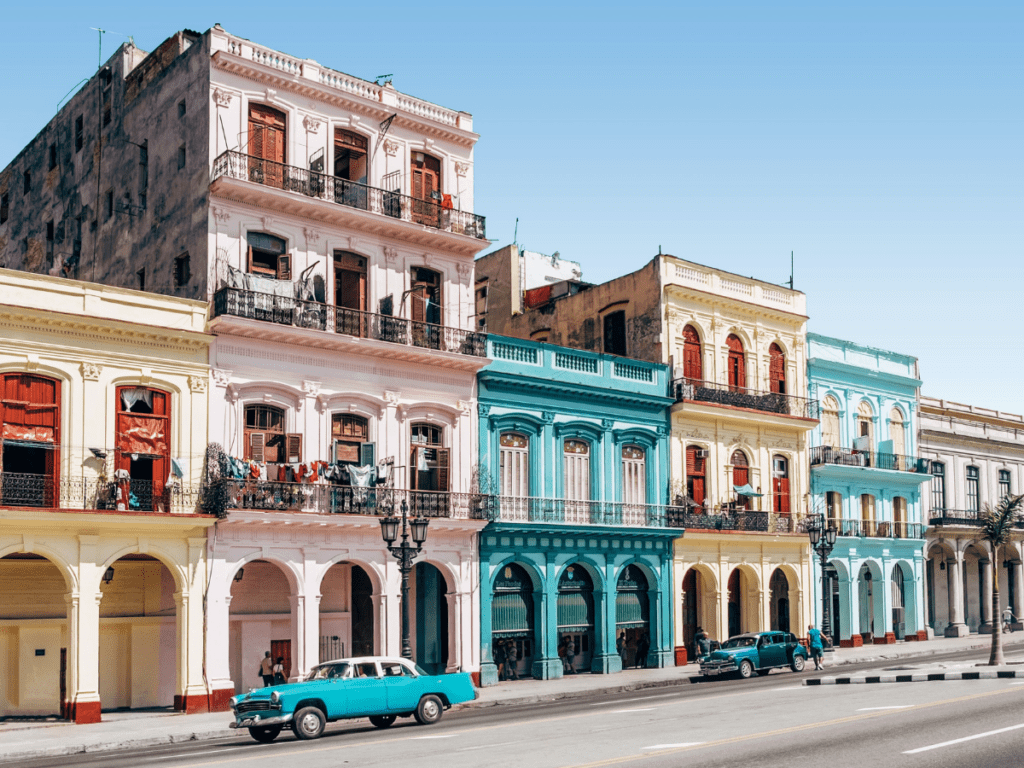
Learn About the Cuban Revolution
Cuba is so much more than the Cuban Revolution! The evidence of the revolution is everywhere, certainly, but there is so much more you’ll see and learn here as you meet the people, try the food, and see the art here in Cuba.
Make sure to visit these sites if you’re interested in learning more about the Cuban Revolution:
- Plaza de la Revolución in Havana
- Comandancia de la Plata in the Sierra Maestra mountains , the mountain base where Fidel and his band of revolutionaries launched their attacks
- Museo de la Revolución , a former presidential palace converted into the Museum of the Revolution in Havana. You’ll find American tanks captured in the attack on the Bay of Pigs behind the museum.
Learning more about the Revolution can be absolutely fascinating for visitors, and a great way to understand more of what you’re seeing and experiencing.
Make sure to check out this free walking tour in Havana focused on the Revolution as a fantastic way to learn more about what you’ll see in Cuba!
Want to learn more?
We made a list of a few books to read and movies to watch to inspire your travel and help you learn more about Cuba, past and present. Check them out before you go to learn more about the Cuban Revolution and much more.
- Books to Read Before You Travel to Cuba
- Movies to Watch Before You Travel to Cuba
Top Activities in Cuba
This list doesn’t even scratch the surface of what Cuba has to offer.
Make sure to check out our complete guide to the best travel experiences and activities in Cuba – totally travel-restriction compliant for travelers from the United States!
Where To Stay in Cuba
Casa particularles.
Casas Particulares – or, guest houses – are a fantastic option for staying in Cuba. You can find an amazing selection of rentals of all kinds, from luxury beach houses to staying with a family in a spare bedroom or renting a simple city apartment.
Not only do rentals usually get you a lot more for your money, but you’re supporting small business in Cuba and you’ll get a much richer cultural experience.
We’ve always had the best luck searching with, ironically, Hotels.com .
Despite their name, Hotels.com actually has a great selection of guest houses, private apartments, and Airbnbs for rent – with the best selection for Cuba!
Casa Particular Guides:
- Best Casas Particulares in Old Havana
- Best Casas Particulares in Vedado, Havana
- Best Casas Particulares in Viñales, Cuba
- Best Casas Particulares in Holguin, Cuba
Airbnb is one of the most popular platforms for finding rentals, but plenty of others exist as well and many people rent their listings across multiple platforms.
While we always recommend staying in a casa particular over a hotel, there are more and more amazing options in Cuba these days.
There are several new luxury hotels in Havana and in Cuba’s beach towns, but I recommend the boutique hotels like this one which can be just as luxurious and offer a more personalized stay.
All-Inclusive Resorts
There are many all inclusive resorts in Cuba, especially from companies like Iberostar and Melia , and they’re especially lovely ones located in Varadero and the Cayos – the Keys – on the northern coast of Cuba.
Cuba Accommodation Guides
- Where to Stay in Viñales, Cuba
- Where to Stay in Holguin, Cuba

Cuba can be a tough place to pack for – you’ll probably be combining time in the city, on the beach, or in the countryside.
Plus, there are a lot of things you just WON’T be able to find in Cuba no matter how hard you look, meaning you need to plan ahead!
We created an ultimate packing list for Cuba – so make sure to click through to this list to see all of our recommendations for packing (for men and women), plus important travel essentials!
Cuba Travel Essentials
- CASH – if you’re a U.S. citizen, you won’t have access to debit or credit cards while in Cuba . Check out our guide to traveling with cash in Cuba for more details.
- SteriPen – purify water from any source so you won’t get sick!
- Water Bottle (with water filter!)
- S-Biner locks for backpacks and purses while out and about
- Luggage locks
- Comfortable and lightweight basics – I love Los Angeles Apparel clothes for travel, especially to Cuba. These high-quality basics are perfect for layering, and mixing and matching for traveling light (PLUS they’re ethically produced in the United States).
- Go Toobs are the BEST for bringing toiletries.
- Make a mini first-aid kit with a few bandaids, aspirin, triple antibiotic, and alka seltzer just in case!
- Reef-safe sunscreen
- Light clothing that will keep you cool in the sun
- Comfortable shoes – get ready for a lot of cobblestones and uneven sidewalks
- Feminine Hygiene Products- I have NEVER been able to find tampons in Cuba – and the period products I have had to purchase there are incomparably bad. Absolutely come prepared, ladies!
- A electrical plug adapter and converter
- A tablet (we love the Amazon Fire !) pre-download some audiobooks and any TV shows or movies you’ll want to watch while you’re in Cuba… internet speeds in Cuba will make downloads slower than you’re used to or impossible.
- A spare memory card for your camera – also something that can be extremely challenging to find in Cuba!
- NordVPN or another Virtual Private Network service . Not a physical product, but something you shouldn’t travel without! Check out our guide to using a VPN in Cuba , and our guide to using a VPN for international travel .
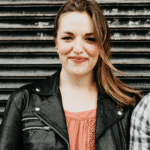
Carley Rojas Avila
Carley Rojas Avila is a bilingual travel writer, editor, content marketer, and the founder of the digital travel publications Home to Havana and Explorers Away. She is a serial expat and traveler, having visited 40+ countries and counting. Carley has written for publications like Travel + Leisure, MSN, Associated Press, Weather Channel, Wealth of Geeks, and more. Find her front row at a Bad Bunny concert, befriending street cats, and taste-testing every pizza in Havana.

Cuba Travel Guide for U.S. Citizens: What to Know Before You Go (Updated 2023)
Feb 3, 2023 | Caribbean , Destinations | 0 comments

Planning this trip to Cuba was the most challenging thing I’ve done to date in the name of travel. Out of all 26 countries, thousands of miles, from 5 years of traveling the world.
Once we landed in Havana, I knew that this place was unlike any I’d visited before.
Had I allowed the logistical challenge of traveling to Cuba as a US citizen deter me from visiting this country, it would have been my greatest mistake.
This Cuba travel guide for US citizens is up to date as of early 2023, based on my experience traveling to Cuba in December 2022.
In this post, I will cover Cuba travel FAQ and share how to visit Cuba legally as a US citizen or from a US airport.
Before you read, please note that there are sanctions from the U.S. government that restrict travel to Cuba.
It is the responsibility of each visitor to follow all laws and regulations, at home and abroad.
This website has a limitation of liability policy that applies to all posts, which you can read here .
This post contains affiliate links. See more in the disclaimer .
Can Americans Travel to Cuba?
Yes. And you can even do so independently.
The key is to visit legally, within the confines of OFAC (Office of Foreign Asset Control) regulations due to the embargo and sanctions.
IMPORTANT: These regulations also apply to non-US citizens that are departing from a US airport.

How to Travel to Cuba Legally
There are 12 categories of legal travel to Cuba under OFAC:
- Family visits
- Official business of the U.S. government, foreign governments, and certain intergovernmental organizations
- Journalistic activity
- Professional research and professional meetings
- Educational activities
- Religious activities
- Athletic competitions by amateur or semi-professional athletes or athletic teams
- Support for the Cuban People
- Humanitarian projects
- Activities of private foundations or research or educational institutes
- Exportation, importation, or transmission of information or information materials
- Certain authorized export transactions
Source: U.S. Department of the Treasury
The most common is Support for the Cuban People, which requires the following:
§ 515.574 Support for the Cuban People. (a) General license. The travel-related transactions set forth in § 515.560(c) and other transactions that are intended to provide support for the Cuban people are authorized, provided that: (1) The activities are of: (i) Recognized human rights organizations; (ii) Independent organizations designed to promote a rapid, peaceful transition to democracy; or (iii) Individuals and non-governmental organizations that promote independent activity intended to strengthen civil society in Cuba; and (2) Each traveler engages in a full-time schedule of activities that: (i) Enhance contact with the Cuban people, support civil society in Cuba, or promote the Cuban people’s independence from Cuban authorities; and (ii) Result in meaningful interaction with individuals in Cuba. (3) The traveler’s schedule of activities does not include free time or recreation in excess of that consistent with a full-time schedule. Source: Code of Federal Regulations
It will not be a vacation where you go to the beach and prop your feet up, buy things wherever you want, and stay wherever you want.
You must have a full-time schedule of activities that result in meaningful engagement with Cubans.
For us, that looked like many, many art tours and private gallery visits where we connected with local artists and had countless meaningful, deep conversations.
No topic was off-limits.
Everyone opened up (including us) and shared our passions, life experiences, opinions, and learned about one another. And yes, we talked about politics.
We were on the go, all day, every day.
And we didn’t really spend time with other foreigners. We crossed paths with foreigners a couple times, but everyone else we spoke to and spent time with was Cuban.

Casas particulares and paladares
Aside from your full-time schedule, you should also stay in casas particulares and eat at paladares.
A casa particular is a room in someone’s house. It’s been a normal way to travel in Cuba for years. There’s an infrastructure around it. You can find them on Airbnb.
We highly recommend this casa particular in Havana and this casa particular in Viñales.
Paladares are privately-owned small restaurants. Download A La Mesa for a list of restaurants all over the country. Each listing shows if it’s privately-owned.
The app also works offline, which will make your life much easier in Cuba.
Pro tip: If you’re also a vegetarian, make sure you try Camino al Sol ! It’s an all-vegetarian paladar in Havana.

What you are banned from doing in Cuba
You cannot spend money in OR interact with any of the places on this list from the US Treasury Department.
Many are hotels, so pay attention!
I copied and pasted these into a list to have on my phone, then accessed it offline while in Cuba to ensure there wouldn’t be any issues.
Is Cuba safe to visit?
Absolutely.
As a young woman who visited 25 countries before going to Cuba, I’ve been in a few…sticky situations. Cuba was amazing.
I never worried about being robbed and just felt at ease the entire time I was there. I tend to be a more anxious person, so that’s new for me.
This is my personal experience and I was not in Cuba as a solo female traveler, so yours could be different.
Is Cuba open for travel right now?
As of late 2022, visitors no longer need to show proof of Covid-19 vaccination or testing before entering Cuba. We brought our vaccine cards just in case, but no one asked to see them.
Please refer to this government site for updated information before your visit.
On our way back to the United States, we did have to share contact tracing information with our airlines using a form before we could check in. It was quick and easy.
Although many online sources claim masks are mandatory in certain settings, we did not see any places where masks were required in December 2022.

Accessing Money in Cuba: 2023 Updates
Everything you need to spend in Cuba must be in cash.
Because of the sanctions, your credit and debit cards will not work in Cuba.
If you try to use them, your bank will probably lock your account and it will take a lot of effort to get it unlocked.
In prior years, you would need to convert money to Cuban pesos before using it. Euros were the best to have because CADECA (the government exchange houses) charged a higher fee on USD exchanges.
As of late 2022, everywhere we went accepted U.S. dollars as payment. This was highly unexpected and deviated from every piece of advice I read online before leaving for Cuba.
However, it is still good to have some pesos for a fairer exchange rate. Some menu exchange rates were awful.
When we were in Cuba, we typically got 150 CUP for 1 USD. The CADECA rate was 110.40 CUP for 1 USD.
We exchanged money at our first casa particular and spent USD on activities, private taxis, and one of our casas. We usually spent pesos on art, food, and coffee.
Make sure you get cash in plenty of small bills. Twenties, tens, fives, and ones were useful. Anything larger than that will be annoying to deal with.
If your bank will only give you large bills, go to Publix and ask the customer service to break them when they’re not busy. Works like a charm!

Is it safe to exchange money on the street in Cuba?
You will be offered money exchange on the street wherever you go in Cuba. Just say “No, gracias,” and move on.
As a general rule of thumb, it is not safe or advised to exchange money on the street. This goes for wherever you are in the world.
The main reason it’s unwise to do this is forged currency. If it came from some random person, it may be counterfeit.
A local friend taught us how to know your Cuban pesos are real. Hold the bill up to the sun, and check the watermark.
The watermark will have a number on it, and that number must match the value of the bill.
If it’s a 100-peso bill, the number in the watermark should say 100.
Again, I do not recommend exchanging money in the street. We didn’t on this trip because we were able to get pesos from the front desk of our casa particular.
If you’re ever concerned about any bills you were given as change, use the tip from our friend for some peace of mind.
I also want to make it clear that we were never given counterfeit bills as change while in Cuba, but these things can happen anywhere.
You’re more vulnerable as a foreigner, because you don’t know exactly how the money is supposed to look.

Getting WiFi in Cuba
If a travel guide says there are only one-hour WiFi cards, it is outdated.
Now, you can access WiFi on a one-hour or a five-hour card.
WiFi is now cheaper in Cuba—it was $5 USD per hour; now, it’s $1 USD per hour.
We only needed one 5-hour card per person for the whole week.
Instead of waiting in the ETECSA line, we bought them from our first casa particular .
Overall, our Cuba WiFi experience was much easier than what we expected.
Don’t expect to be online all the time, but WiFi access is not as difficult as prior years.
Pro tip: The two main apps I highly recommend to download BEFORE you leave for Cuba are A La Mesa and Maps.me . Both work well offline and will save you such a headache.
On Maps.me specifically, also download the maps of each city/town you will visit in Cuba. In our case, I downloaded the maps for Havana and Viñales. When you have Internet access, put your casa particular addresses in a Note on your phone, so you copy and paste them into Maps.me whenever you need to. Same goes for any attractions you know you want to see.
If you want (and if your phone is unlocked), you could get a Cuba sim card, which comes with data. I don’t see the point for a one-week trip, but to each their own.
You can reserve those online in advance from Suena and pick them up at the José Martí airport (in Havana). If you go this route, you want the Tourist SIM Card from the top menu.

Can you drink the water in Cuba?
In short, no.
There was bottled water for sale everywhere on our trip in December 2022, but I read online before leaving that you can’t bank on that.
Instead, I bought this LifeStraw to have filtered water and it was the best travel purchase I’ve made. Ever.
Our Viñales casa particular hostess took one look at that bottle and pointed me to her giant drinking water spigot for us to have freely.
She was already familiar with the water situation for foreigners and told me it was smart to bring a reusable filtered bottle.
Highly recommend one of these !

Can you check in online for flights to Cuba?
There are too many documents the airlines must verify before they can issue a boarding pass.
You will also need a paper boarding pass for your Cuban health insurance, often included in your departure airfare.
Do you need to speak Spanish to visit Cuba?
Out of all Spanish-speaking countries I’ve visited, Cuba is the main one you need at least some language skills to visit.
There are people who speak English, especially young people, but it is not the norm.
If you don’t speak Spanish and you’re not traveling with a friend who does, download Google Translate for offline use before you arrive.
It won’t be ideal, but it will work when you need language help.
The best advice I can give is to travel with someone who speaks Spanish fluently. My best friend said many times while we were in Cuba that she would be toast without my language skills.

Can I bring Cuban cigars and rum back into the USA as souvenirs?
The answer used to be yes, as long as you purchased them from a private shop instead of a stated-owned one.
That answer is no longer the case, as of late 2022.
Now, you cannot bring any rum or cigars into the USA from Cuba, no matter how small the amount is or where they were purchased within Cuba.
When you arrive back into the USA, Customs and Border Patrol will ask if you have any rum or cigars. If you do, assume they will be confiscated.
What to Pack for Your Cuba Trip
I pack carry-on only and found Cuba to be one of the easier countries to pack for. The climate in December was perfect, with 80s in the day and 60s-70s at night.
Here is a short packing list of the things you need before going to Cuba:
- Mosquito repellent, because the insects in Cuba will eat you alive (I use these .)
- Comfortable shoes for lots of walking
- Cardigan or light sweatshirt
- Flowy/comfortable clothes (You can see one of the outfits I packed below.)
- One active wear outfit for hiking/horseback or bike riding (if you’re going to Viñales)

I hope this Cuba travel FAQ was helpful for you. I know how stressful it can be to figure out what to do when planning. If you have any questions, comment below and I’ll do what I can to help!
Read more Cuba travel guides:
- Cuba Pre-Departure Checklist
- What to See and Do in Cuba (Havana and Viñales)
- At Dusk in Havana, I Fell in Love
- Havana, the Art Sanctuary
- When It Destroys, It Starts with Us
- The Elephant in the Room: Socialism in Cuba
Save on Pinterest

Share this:
- Click to share on Facebook (Opens in new window)
- Click to share on Twitter (Opens in new window)
- Click to share on Pinterest (Opens in new window)
- Click to share on Reddit (Opens in new window)
Leave a Reply Cancel reply
Hi, I'm Sarah

Welcome to my oasis! I am a writer and budding entrepreneur with a love for caffeine, capital gains, and seeing the world. If I'm not writing, you can find me reading a good book, trying out a new vegan recipe, or adding to my coffee mug collection. My goal in life? To see every country in the world. Come along for the ride!

- Destinations
Cuba Travel Guide
National Geographic’s latest travel stories about Cuba
- Terms of Use
- Privacy Policy
- Your US State Privacy Rights
- Children's Online Privacy Policy
- Interest-Based Ads
- About Nielsen Measurement
- Do Not Sell or Share My Personal Information
- Nat Geo Home
- Attend a Live Event
- Book a Trip
- Inspire Your Kids
- Shop Nat Geo
- Visit the D.C. Museum
- Learn About Our Impact
- Support Our Mission
- Advertise With Us
- Customer Service
- Renew Subscription
- Manage Your Subscription
- Work at Nat Geo
- Sign Up for Our Newsletters
- Contribute to Protect the Planet
Copyright © 1996-2015 National Geographic Society Copyright © 2015-2024 National Geographic Partners, LLC. All rights reserved
Trinidad (Cuba)

- 1 Understand
- 2.2 By taxi or colectivo
- 2.3 By train
- 3 Get around
- 8.2 Mid-range
Trinidad (sometimes called Trinidad de Cuba ) is a city in Central Cuba . It is a UNESCO World Heritage Site .
Understand [ edit ]
As a UNESCO World Heritage, Trinidad is a must see on your trip to Cuba offering a beautiful and mostly preserved old town.
Get in [ edit ]
By bus [ edit ].
- 21.80517 -79.98659 1 Central Bus Station . Viazul buses have a twice daily service from Havana stopping at Cienfuegos , and a daily service from Santiago de Cuba stopping at Holguin , Camagüey , and Sancti Spiritus . There is also a service to/from Varadero stopping at Santa Clara and Cienfuegos that is not listed on the Viazul website. It leaves Varadero at 07:30 and returns from Trinidad at 14:25. Viazul and Cubanacan offer direct buses from Viñales as well. You buy Viazul tickets from the air conditioned office right in front of where the buses park, not from the Astro or local bus counters. ( updated May 2015 )
By taxi or colectivo [ edit ]
You can also get in and out quicker by taxi, specifically, colectivos at about the same price as a Viazul bus ticket. When going to Havana this is also more convenient, as you will not be dropped off at the Viazul station, but will instead be driven to the desired location. Drivers can be found at the central bus station or around the 21.8031 -79.98534 2 Cubatour Office . If you organize your transport at least a day in advance, the driver will pick you up at the desired time at your hotel or casa. In April 2022 the cost of a colectivo (airconditioned minivan for 7 passengers and driver -- they are always full) from Havana to Trindidad is 35 euros or 40 dollars per person.
By train [ edit ]
Trinidad has not been connected to the rest of Cuba by train since a hurricane destroyed an essential bridge in 1992. There is a local train running to the Valle de los Ingenios from the 21.79703 -79.98942 3 tiny train station . In April 2022 the train is not running because the locomotive is broken and pending repairs. The man guarding the engines in the depot across the road from the station will give you a short tour if you wish.
Get around [ edit ]

See [ edit ]
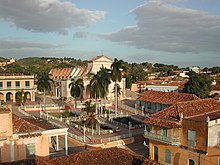
- 21.806337 -79.984948 3 Museum of the War Against the Bandits ( Lucha Contra Bandidos ). The museum is in a former convent close to the cathedral near the Plaza Mayor in the old colonial center. The War Against the Bandits was the 1961-1969 fought against U.S.-sponsored counterrevolutionaries, who hid out in the nearby mountains. If you do not read Spanish, the displays may be difficult to understand, but the piece of the American U-2 spy plane shot down speaks for itself. Also well worth the entrance fee is the mirador (view) from the convent's tower, reached by several flights of wooden stairs, which has superb views across the whole town. ( updated May 2015 )
Do [ edit ]
- Old Colonial Center . Walk around in the old colonial center. Check out the colonial homes and furniture too. The houses are open and some of the antiquities are visible from the streets. Also the market in the old colonial center is nice to walk around and look at the handicrafts. Drawn thread tablecloths and linens seem to be a speciality. The vendors are refreshingly laid back, you can look around and get virtually no hassle or pressure to buy. ( updated May 2015 )
- 21.8138 -79.9767 1 Viewpoint Cerro de la Vigía ( To get there, continue up the hill northeast from the Plaza Mayor. ). Climb the hill behind the town to get a great view. As you walk up the hill you go through poorer neighbourhoods. You may be asked for clothes or trinkets by the local kids. Seems pretty safe during the day but be careful at night. As you exit the city you’ll also pass by the Disco Ayala , a discothèque in a cave near the top of this hill. ( updated May 2015 )
- 21.913935 -80.018911 2 Topes de Collantes National Park . The national park starts just outside the city and features some great views and many hikes, some of which leading to waterfalls, rivers or ponds. The closest park area is El Cubano and it’s possible to even walk there (4-5km one way), yet the park areas further up the hill (around the village of Topes de Collantes) have a greater variety in plants and more of a jungle feeling. The parks are accessible either by car, by taxi (expect about US$30-40 for the car to drive there including pick up in the evening) or by taking one of the day tours offered by Cubatur. (The local bus service to Topes de Collantes has not run in years.) Access is free, though transport is not and most hikes will charge an entrance fee of about ~US$3-9 . ( updated May 2015 )
- 21.7331 -79.9971 3 Playa Ancón ( Ancón beach ) ( Ancón peninsula ). The peninsula is one of the few places in Cuba where you can access a great beach without staying at a resort hotel. A taxi will take 10-15 min to get there for ~US$6-10, there’s also an (often very overcrowded) bus leaving 4 times a day from the Cubatur and Havanatur (round-trip ~US$2 per person) and the beach is also well within biking distance from Trinidad (though cycling in the hot sun can be quite strenuous). Make sure you have sunscreen and mosquito repellent, especially if you intend to stay on the beach in the evening. Few boats also provide snorkeling facilities. Free, beach chair ~US$2 . ( updated May 2015 )

- 21.84761 -79.97012 5 Waterfall . Behind the waterfall is a cave you can swim into. In summer times, it is recommended to take a swim in the water fall. Usually, also an improvised pub with few drinks is available. ( updated Oct 2017 )
- Take cheap, private and professional Salsa lessons for men or women. Many people will offer dancing classes. Have a peek to see what you’re getting into. (Senora Misladis, tel. 99-4493 has a private studio in her home).
Learn [ edit ]
If you want to learn Spanish during your stay in Trinidad you can take an Intensive Spanish course from one week up to four weeks. The classes are held 4 hr per day and give you the opportunity to improve your Spanish quickly during a short time period.
Buy [ edit ]

There are several convenience stores in town. In contrast to other places in Cuba, the 5-l water canister costs CUC3 instead of CUC1.90.
- 21.80195 -79.98533 1 Bank with ATM ( Banco de Credito y Comercio ) ( in the center of José Martí street ). ( updated May 2015 )
Eat [ edit ]
Budget [ edit ].
There are several 'so called' peso pizza establishments in the town which allow tourists to purchase Pizza for the national peso price. This usually works out at around CUP5-10. This is a good idea for travelers on a budget. One of the biggest places in Trinidad is situated on the corner of Frank Pais and Francisco Javier.
- 21.80023 -79.98412 1 Local food stall . This cheapie has a fixed menu, but offers actual dishes. Worth trying out if you’re already sick of peso pizza. ~US$1 . ( updated May 2015 )
Mid-range [ edit ]
Many casa particulares offer dinner, typically for around CUC10 per person. If you did not yet try local food, these usually authentic dishes are very well prepared and well worth checking out. However, Trinidad also has a good variety of restaurants and some serve food that’s hard to come by elsewhere. Note that the restaurants listed in guide books are typically well visited, so you may have to queue for a seat when coming between 19:00-22:00.
When wandering around the city, touts may offer to guide you to a restaurant. If that happens, kindly refuse their service or be prepared to have their commission added to the bill.
Highlights include:
- 21.80653 -79.98405 2 La Botija . This authentic tavern with antique interior of the colonial slavery times has a great atmosphere and serves delicious food (mostly tapas, but also others like pizza) on fancy plates self-made from beer bottles. They have a band playing really good jazz & funky live music which may be a welcome relief from the typical salsa rhythms. The place fills up quickly, so it’s best to be there before 19:30. Tapas US$1-3 . ( updated May 2015 )
- 21.80189 -79.98366 3 Paladar San José . This place seems to be a favorite one of German tourists, but nevertheless serves very delicious international food and has very friendly and welcoming staff. The place also fills up quickly, so it’s best to come early. ( updated May 2015 )
Drink [ edit ]
In the square at night, there are often events and there is a very good club open until the early hours.
It is a lovely town with amazing visitors and inhabitants, and small enough for you to wander and choose your drinking hole. The Mojito's and rum cocktails are great.
- Casa de la Musica – There are two bars in the main Trinidad square and there is live music from 21:00 till late. There is lots of dancing and reasonably priced cocktails.
- 21.80815 -79.98106 1 Disco Ayala ( in a cave at the northern end of city ). This disco is located within an actual cave and it has become quite famous. The cave is huge with stalagmites and stalactites. More tunnels and caves can be seen near the bathrooms. This is where young Cubans go to party, the music is mainly reggaton and techno. Fun starts after 23:00. Very much worth checking it out. CUC10 . ( updated Apr 2015 )
There are also places where the locals hang-out and which serve quite decent beer at a very reasonable price. These places usually serve draught beer and stay open just as long as there is beer to serve. When the beer from one place has been drunk, then it's off to the next place or not. Many of the locals drink their beer outside on the street and Trinidad is so small so these places are easy to spot.
Sleep [ edit ]
- 21.80084 -79.984245 1 Iberostar Grand Hotel , ☏ +53 41 996070 . A beautiful colonial hotel on the main causeway up to the square. It is a little expensive, but worth it as it has colonial rocking chairs and 2 four poster beds. ( updated Feb 2016 )
- Hostal "Felina y Otto , 711 Frank Pais . The accommodation is on the top floor of the house and is very private and features a roof terrace. The hosts offer a good breakfast (~US$3) and Dinner (~US$7). Food is delicious and the hosts are happy to provide advice on local attractions. ~US$15 per night excluding food . ( updated Feb 2016 )
There are many casas particulares in Trinidad. It is an excellent way to meet the people of Trinidad and see how many live.
- Casa de Benito Rodríguez Rodríguez , 33 Gustavo Izquerdo ( between F.J. Zerquera and Colon ), ☏ +53 41 994145 . Two large rooms with a shared bath in a colonial house filled with antiques. The food is excellent. Best of all, Benito and his wife are very nice and helpful, such as finding you another casa if their rooms are booked.
- Lida Hernández Sandoval , Calle Mario Guerra #184 ( between José Marti and Frank País ), ☏ +53 41 994100 . Three rooms but only one license so this is one of the few casas that can rent to tourists who are traveling with Cubans (for example, if you hired a driver). Good food and lots of room for a big group.
- Casa de la Amistad , Zorquera (Rosario) ( between Marti and Frank Pais ). Centrally located hostal, popular amongst revolution sympathisers, run by ICAP (Instituto Cubano de Amistad con los Pueblos). Clean, a/c, tv, fridge, hot water (from a tank not the electric type that give you a shock if you touch them). ~US$25 for a double room .
- 21.801657 -79.986664 2 La Niña , Fco. J. Zerquera (Rosario) #171 ( 5 min walk from bus terminal ), ☏ +53 41 992411 . Pretty colonial house with courtyard. Located in the center of the city. Comfortable room, a/c, fridge and good hot water. Very friendly couple. Huge and delicious breakfast included. Delicious evening meals also available. Secure. Keys to street and room provided. ~US$25 .
- Casa Marla y Fernando , Gustavo Izquierdo (Gloria) #103-A , ☏ +53 41 993910 . Colonial house with a nice terrace. Fridge, a/c, hot water. Very friendly couple. Optional delicious breakfast and/or dinner.
- Dra. Onidia Puente Landestoy , Camilo Cienfiegos #33 entre Pedro Zerquera y Anastacio Cardenas Tdad S-Spiritus , ☏ +53 41 998221 , +53 41 836716 . 2 brand-new rooms, each one with a tv, air-conditioner, fridge, a double bed and a single bed, and fancy shower and toilet. The owner, Onidia, is friendly, fun to talk to, speaks some English, and live in the house with her mother and her daughter. Location is about 4 blocks from Parque Cespedes. Great room for a decent price.
- [dead link] Casa Las Tres Naranjas , Clemente Pereira (Cruz Verde)#108 ( between Simon Bolivar (Desengano) and Fidel Claro (Angarillas) ), ☏ + 53 55 61 2929 (mobile), +53 55 61 2928 (mobile), + 53 41 99 8429 , [email protected] . B&B run by a young couple, native speakers of English, Dutch and Spanish. Two rooms, each with a queen size bed. They are connected by a large shared bathroom. Additionally one children's bed is available. To cool off the rooms include fans, large windows, as well as air conditioning. There's a garden, private balconies and rooftop terrace with views of the Escambray Mountains. ( updated Apr 2018 )
Go next [ edit ]
- Before going back to Havana , make a stop at Cienfuegos or enjoy some beach or diving time at Playa Giron or Playa Larga .
- La Boca or the nearby Playa Ancon make for a nice day trip
- Nearby destinations also include Santa Clara and Sancti Spíritus
- UNESCO World Heritage Sites
- UNESCO tag to be fixed
- Has custom banner
- Has map markers
- Has mapframe
- Do listing with no coordinates
- Sleep listing with no coordinates
- Articles with dead external links
- Usable cities
- Usable articles
- City articles
- Has Geo parameter
- Central Cuba
- All destination articles
- Pages with maps
Navigation menu
Cuba Travel
Cuba Travel is the official tourism website in Cuba. It delivers the most complete and updated information on Cuba’s tourist poles and its main assets as a tourist destination. It’s the sales channel with the largest inventory of Cuban tourist products and services that guarantees the best internet price.
Share Cuba Travel
- Great places to visit
- Edit source
- View history
Cuba is an Island in the South Carribean. These country has a population of 41 million people. 20 million are men and 19 million are woman. Its current Prime Minister is Manuel Barrero Marrero.
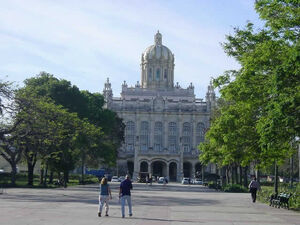
Presidential Palace in Havana, now the Museum of the Revolution
- 1 Hotels and lodging
- 2 Attractions
- 4.1 Getting to Cuba
- 4.2 Exploring Cuba
- 5 Practical information and resources
- 6.1 Text with links to user-reviews on other pages
- 7 Nightlife
- 8 Photo gallery
- 9 Everything else
- 10 External resources
Hotels and lodging [ ]
Attractions [ ].
- Dolphinarium "El Laguito"
Show Schedule: 11am and 3pm. Open: daily from 9.30am-5pm.
Located in mid- Varadero close to the southern highway, this attraction is a great way for families and kids to get close to everyone's favorite sea animal. Two dolphins' shows daily and the opportunity to swim with the "stars".
Shopping [ ]
Maps and transportation [ ], getting to cuba [ ], exploring cuba [ ].
- Modern Havana is a region of Havana Cuba , wich begins in Vedado, northwest of the Old Town. 23rd Street, is the city´s main axis, also known as "La Rampa" (the Ramp) because of the gradual rising of its lower section. Luxury hotels like the National and the Habana Libre line this street, a remarkable legacy of years gone-by. The neighboring streets teem with Art-Nouveau houses and villas. The political center lies at Revolution Square and its surrounding buildings. Close by, Columbus Cemetery expands on itself, today a National Monument and a genuine marble city for the deceased, dating back from the late 19th century. Further ahead, the aristocratic section of Miramar joins the landscape, with palace-like villas which have been turned into embassies, expensive restaurants and exclusive stores.
Practical information and resources [ ]
Restaurants [ ], text with links to user-reviews on other pages [ ], nightlife [ ], photo gallery [ ], everything else [ ], external resources [ ].
Add links to other sites here
- Cuban Goverment See also
- Portal Cuba.cu
- Cuba Travel
- Cubanacan Groupo
- Allways Travel
- Paradiso Turismo Cultural
- Parlamento Cubano
- Instituto de Meteorología, Inicio (Weather information in Spanish )
- Cuba Review
- News and informations on Cuba travels
- GrandSlam Limited, Travels to Cuba, eco-tourism, fishing, cultural, flights, hotels
- 1 Woodland Park Zoo
Advertisement
Supported by
How a Crypto Compliance Officer Ended Up in a Nigerian Prison
Tigran Gambaryan, an American compliance official for the giant cryptocurrency exchange Binance, flew to Nigeria in February for a planned two-day business trip. He hasn’t returned.
- Share full article

By David Yaffe-Bellany and Emily Flitter
David Yaffe-Bellany reported from San Francisco, and Emily Flitter from New York.
When he flew to Nigeria for a business trip in late February, Tigran Gambaryan, a top compliance officer at the cryptocurrency exchange Binance, packed a small suitcase with just enough clothes for two days.
A former U.S. law enforcement agent, Mr. Gambaryan knew the trip was risky. Only a few weeks earlier, he and a group of colleagues had rushed out of Nigeria, concerned that the local authorities might detain them, five people familiar with that trip said. This time, he assured his wife, he would “get in and get out.”
A month and a half later, Mr. Gambaryan is being held at Kuje prison in the Nigerian capital of Abuja, a complex that has housed Islamic State militants and Boko Haram fighters.
After meeting with government officials in Abuja on Feb. 26, Mr. Gambaryan, 39, and a Binance colleague, Nadeem Anjarwalla, were abruptly escorted to a guesthouse controlled by Nigerian security officials, where they were held for nearly a month with no formal charges filed against them.
Then, late last month, Mr. Anjarwalla, the company’s regional manager for Africa, escaped under mysterious circumstances. Initial reports suggested he had fled Nigeria after guards permitted him to leave the guesthouse for Ramadan prayers.
Within days of the escape, the Nigerian government charged Mr. Gambaryan, Mr. Anjarwalla and Binance itself with tax evasion and money laundering — effectively accusing the company and two midlevel employees of the same crimes.
This account of Mr. Gambaryan’s detention in Nigeria is based on interviews with Nigerian officials, crypto compliance experts and a dozen other people with knowledge of the situation, many of whom requested anonymity to discuss a legally sensitive matter.
In an April 3 statement, Binance denied that Mr. Gambaryan had any “decision-making power” in the company and said he should not be “held responsible while current discussions are ongoing between Binance and Nigerian government officials.”
A Binance spokesman, Brad Jaffe, said the company had “great respect” for the Nigerian government and remained engaged in “good faith discussions at all levels.”
Mr. Gambaryan’s arrest is the latest flashpoint in years of legal troubles for Binance, the world’s largest crypto exchange. The company is trying to rebuild after it agreed to pay $4.3 billion in penalties last year to settle charges by several U.S. agencies that it violated economic sanctions against Syria, Cuba and Iran while allowing criminal activity to flourish on its platform.
The case also shows how the crypto industry, built on technology that was originally designed to circumvent the global financial system, is still struggling to stay on the right side of law enforcement in countries around the world. In November, Binance’s founder, Changpeng Zhao, stepped down as chief executive and pleaded guilty to money-laundering violations in the United States.
Binance replaced Mr. Zhao with Richard Teng, a former Singaporean regulator, and continued to operate worldwide, but with a smaller staff after it laid off 3,000 of its nearly 8,000 employees last year.
Around the time of the leadership change, Binance was working with the Nigerian government, hoping to collaborate on efforts to monitor crypto transactions for financial crime. But those discussions deteriorated as Nigerian officials voiced suspicions that Binance was committing some of the same crimes that the United States had investigated.
With one of the largest economies in Africa, Nigeria has recently become a hot spot for digital currencies: It has the second-highest rate of crypto adoption in the world behind India, according to Chainalysis, a data firm. Some Nigerians have turned to crypto as an alternative to the local currency, which has depreciated substantially over the past two years.
Mr. Gambaryan, a weight lifter who practices martial arts in his spare time, spent his early childhood in Armenia before moving to Fresno, Calif., as a preteen. He now lives outside Atlanta with his wife and two young children.
Binance hired Mr. Gambaryan to work on compliance issues in 2021 and eventually made him the head of its financial crime compliance team.
By the time he traveled to Nigeria, Mr. Gambaryan had become one of the company’s most recognized employees outside its executive suite. He spoke at conferences, used his pedigree as a former law enforcement officer to help recast Binance as a law-abiding financial firm and met with government officials around the world. He liked to recount his years as a criminal investigator for the Treasury Department, where he was part of the team that investigated crimes linked to the Silk Road, a dark web marketplace. His friends and colleagues described him as fearless and proud of his government service.
In early January, Mr. Gambaryan was part of a delegation of Binance employees that traveled to Abuja for meetings with Nigerian officials, who were concerned that the company was evading taxes and violating anti-money-laundering rules.
The trip soon turned frightening, six people familiar with it said. On Jan. 8, Binance’s delegation met with a group of Nigerian legislators, who read aloud a list of accusations against the company, including tax violations, three of the people said. The Binance delegation asked how it could resolve the government’s concerns.
Peter Aniekwe, a Nigerian lawmaker who attended the meeting, said in an interview that he and his colleagues had told Binance’s employees to speak with the Nigerian tax authority about how much the company owed.
Then one of the lawmakers suggested that the delegation was at risk of detention. “We told them that it’s better to settle or they might not leave Nigeria,” Mr. Aniekwe said.
It was meant to be a casual comment, Mr. Aniekwe said, and not an explicit threat, since legislators have no power to arrest anyone.
Still, the employees were alarmed. That night, a local Nigerian lawyer who was working with Binance told the delegation that the cost of settling the company’s legal problems in Nigeria could exceed $100 million, three people familiar with the talks said.
Fearing for their safety, Mr. Gambaryan and his colleagues cut the trip short and flew out of Nigeria, the people said.
Just a month and a half later, though, Mr. Gambaryan went back.
The decision-making among Binance officials about the return trip was muddled, and it wasn’t clear who made the final call. Friends and colleagues pleaded with Mr. Gambaryan not to go, three people familiar with those discussions said. He responded that he felt a sense of obligation to return, and that he thought he could mend relations with the Nigerian officials, a person familiar with his thinking said.
The debate reached Binance’s top executives, a person familiar with the discussions said. Before Mr. Gambaryan left, Binance received assurances from local officials that he would be safe, the person said, and the company hired a security firm to help him navigate Abuja.
But tensions were growing. A few days before Mr. Gambaryan’s return trip, Bayo Onanuga, an adviser to Nigeria’s president, accused Binance of facilitating trading that had contributed to the collapse of the naira, the country’s currency.
Only one other Binance employee traveled with Mr. Gambaryan — Mr. Anjarwalla, who had also been part of the January delegation. On Feb. 26, they met with officials from Nigeria’s financial regulators and other government agencies. Binance did not send any lawyers to accompany them, a person familiar with the meeting said.
The discussions turned hostile. The Nigerian officials wanted Binance to turn over data for a large swath of its customers, a demand that the company was unwilling to meet, three people familiar with the talks said.
A few hours later, Nigerian officials escorted Mr. Gambaryan and Mr. Anjarwalla to their hotel and ordered them to pack their bags, according to their families. Then they were taken to the guesthouse — a secure compound near the headquarters of Nigeria’s national security adviser. “You’re our guest now,” a Nigerian official told them, according to a person familiar with what happened.
The Nigerian authorities confiscated Mr. Gambaryan’s and Mr. Anjarwalla’s passports, but they were able to keep their phones, allowing them to communicate with family and colleagues. No criminal charges were filed, though a local court issued an order permitting the authorities to detain Mr. Gambaryan and Mr. Anjarwalla pending an investigation.
For weeks, they stayed in a section of the house that included two bedrooms, a living room and a kitchen. Guards holding AK-47s were stationed nearby, a person familiar with the matter said.
Speaking to the BBC in early March, Mr. Onanuga, the presidential aide, said Nigeria’s government was demanding close to $10 billion from Binance “in retribution because they really messed up our economy in a very short time.” (In an interview with The New York Times, Mr. Onanuga said he had meant that Binance “may” have to pay such an amount, and that he had been speculating about the size of a potential fine.)
On March 22, lawyers for Mr. Gambaryan and Mr. Anjarwalla learned that Nigeria was preparing to charge the two men personally with criminal violations, as part of its case against Binance, according to their families. The next morning, Mr. Gambaryan woke up to discover that Mr. Anjarwalla was missing, a person familiar with the matter said.
How Mr. Anjarwalla managed to escape was unclear. A local newspaper reported that Mr. Anjarwalla, who has dual nationality in Kenya and Britain, had used his Kenyan passport to leave Nigeria after handing over his British one. The guards led him to a nearby mosque for Ramadan on March 22, the report said, before he somehow slipped away.
A representative for Mr. Anjarwalla said he had left Nigeria “by lawful means.” A spokesman for Nigeria’s national security adviser said the country’s security agencies were working to obtain an international arrest warrant for him.
“The personnel responsible for the custody of the suspect have been arrested,” the spokesman said.
After the escape, the Nigerian authorities confiscated Mr. Gambaryan’s phone. On March 25, he, Mr. Anjarwalla and Binance were charged with money laundering, tax evasion and other crimes. A judge ordered Mr. Gambaryan to be taken to Kuje, where the Islamic State staged a dramatic prison break in 2022 to free hundreds of its fighters.
Mr. Gambaryan’s family, friends and colleagues have been lobbying U.S. officials to secure his release. “They need to make it clear that this kind of injustice should not be tolerated,” Mr. Gambaryan’s wife, Yuki, said in an interview.
A White House official, who requested anonymity to discuss sensitive diplomatic issues, said the administration was working with the U.S. Embassy in Nigeria to resolve the situation.
Mr. Gambaryan has lawyers representing him in Nigeria and is scheduled to appear in court for a bail hearing on Monday, a spokeswoman for his family said. Before he was taken to Kuje, Mr. Gambaryan recorded a video of himself in the courtyard of the guesthouse.
“Guys, I’ve done nothing wrong,” he said. “I’ve been a cop my whole life. I just ask the Nigerian government to let me go.”
Julian Barnes and Ruth Maclean contributed reporting.
David Yaffe-Bellany writes about the crypto industry from San Francisco. He can be reached at [email protected]. More about David Yaffe-Bellany
Emily Flitter writes about finance and how it impacts society. More about Emily Flitter
Inside the World of Cryptocurrencies
Tigran Gambaryan, an American compliance official for the giant cryptocurrency exchange Binance, flew to Nigeria in February for a planned two-day business trip. Here’s how he ended up in a Nigerian prison .
Two years after the cryptocurrency market crashed, there are signs that crypto is booming again in the Philippines, long a center of crypto activity .
Pushed by a nonprofit with ties to the Trump administration, Arkansas became the first state to shield noisy cryptocurrency operators from unhappy neighbors. A furious backlash has some lawmakers considering a statewide ban .
Ben Armstrong, better known as BitBoy, was once the most popular cryptocurrency YouTuber in the world. Then his empire collapsed .
Federal judges are weighing whether digital currencies should be subject to the same rules as stocks and bonds. The outcome could shape crypto’s future in the United States .
New investment funds that hold Bitcoin have begun trading , and it might be tempting to invest in them. Should you ?

COMMENTS
InsightCuba is a tour operator specializing solely in legal people-to-people travel to Cuba for Americans. This tour offers in-country knowledge and expertise that is unmatched in the industry, providing travelers with once-in-a-lifetime experiences. Sea Kayak Adventures, ☎ 1-800-616-1943, [x].
1 Havana - cosmopolitan capital with a swinging nightlife. 20.344444 -74.495556. 2 Baracoa - a quaint beach-side town, and Cuba's first capital. 21.378611 -77.918611. 3 Camagüey - Cuba's third-largest city is a maze of narrow alleyways, Catholic churches, and jars known as tinajones. 22.145556 -80.436389.
Tourism in Cuba is an industry that generates over 4.7 million arrivals as of 2018, [1] and is one of the main sources of revenue for the island. [2] With its favorable climate, beaches, colonial architecture and distinct cultural history, Cuba has long been an attractive destination for tourists. "Cuba treasures 253 protected areas, 257 ...
Cuba, officially the Republic of Cuba, is an island country, comprising the island of Cuba, Isla de la Juventud, archipelagos, 4,195 islands and cays surrounding the main island. Cuba is located where the northern Caribbean Sea, Gulf of Mexico, and Atlantic Ocean meet.Cuba is located east of the Yucatán Peninsula (Mexico), south of both the American state of Florida and the Bahamas, west of ...
Highlight. Because Cuba is a warm tropical climate, there's not necessarily a right or wrong time to visit. However, the country does experience two distinct dry and wet seasons. The dry season runs from December to May, where you can expect sunny days with no trace of clouds in the sky, while the wet season runs from June through November.
Before the Communist revolution and subsequent US blockade, Havana was one of the vacation hot-spots of the Caribbean, and since Cuba reopened to tourism in the 1990s, it has become a popular destination once again, albeit with many fewer U.S. citizens, due to an almost total ban on travel maintained by the U.S. federal government.
Your ultimate Cuba travel guide, with tips, things to do, and best things to see in Cuba. Great for first-time and returning travelers. Located on the largest island of the Caribbean, Cuba is a very popular tourist destination and for good reason. Cuba is home to beautiful white-sand beaches, impressive rainforests and waterfalls, vibrant ...
If you're looking to travel to Cuba with kids, you'll find music, carnivals, watersports, horse riding, classic American car rides and much more. Read article. Best Road Trips. From beaches to mountains to historic cities and more, these road trips around Cuba offer access to the best of this enchanting island.
Cuba, officially the Republic of Cuba, is an island country, comprising the island of Cuba, Isla de la Juventud, archipelagos, 4,195 islands and cays surrounding the main island. Cuba is located where the northern Caribbean Sea, Gulf of Mexico, and Atlantic Ocean meet. Cuba is located east of the Yucatán Peninsula (Mexico), south of both the American state of Florida and the Bahamas, west of ...
Cuba is an archipelago made up of the largest island of the Antilles called Cuba, Isla de la Juventud (formerly called Isle of Pines), and another 4,195 cays, islets and adjacent islands. It is located in the Caribbean Sea (or Caribbean Sea), near the coast of the United States and Mexico. Its limits are to the north with the Strait of Florida ...
Greatest Waterfalls in Cuba. Imagine finding yourself in Cuba, surrounded by an exuberant natural environment - where the vivacious green mountains stretch out into a splendid blue sky - while the fresh Caribbean seabreeze brightens your face. And on this tropical voyage, you discover a land of waterfalls on every corner of the island.
Top 9 Things to Do in Cuba. A Day at Maria la Gorda Beach on the Guanahacabibes in Cuba. Top Travel Destinations and Attractions in Cuba. Top Cuba Tour Operators for Americans. Licensed Cuba Travel Providers. How to Travel to Cuba If You Are an American. A Guide to Public Transport in Cuba. Weather in Cuba: Climate, Seasons, and Average Monthly ...
2. Fill out your passenger information in advance. Cuba uses an online form called D'Viajeros to gather traveler information, including immigration and health data, in advance of travel. Fill out the form digitally up to 72 hours before your arrival in Cuba. 3.
We're José and Carley Rojas Avila, a Havana native and a serial expat turned travel writer. We're the creators of Home to Havana. We love Cuba and use our insider knowledge to help fellow travelers just like you discover all Cuba has to offer. Our ULTIMATE guide to travel to Cuba helps demystify Cuba travel. Written by locals, we share the ...
Getting WiFi in Cuba. If a travel guide says there are only one-hour WiFi cards, it is outdated. Now, you can access WiFi on a one-hour or a five-hour card. WiFi is now cheaper in Cuba—it was $5 USD per hour; now, it's $1 USD per hour. We only needed one 5-hour card per person for the whole week.
Cuba Travel Guide. National Geographic's latest travel stories about Cuba. Photograph by Kike Calvo, Nat Geo Image Collection. Latest Stories. The fascinating story of the daiquiri. Travel;
Get information on Cuba Travel Guide - Expert Picks for your Vacation hotels, restaurants, entertainment, shopping, sightseeing, and activities. Read the Fodor's reviews, or post your own.
Cubans are imaginative and joyful by nature. Find in Cuba Travel, Official Tourism Website of Cuba, everything about the Cuban and Cuban identity.
Rail travel in Cuba is more of an adventure that can give you a view into the daily lives of the Cuban people than it is a practical means of transportation. Cuba is also the only Caribbean country to have railways. Interactive map of passenger trains on Cuba. The main train line in the country runs between Havana and Santiago de Cuba, with major stops at Santa Clara and Camagüey.
The island of Cuba was inhabited by various Amerindian cultures prior to the arrival of the explorer Christopher Columbus in 1492. After his arrival, Spain conquered Cuba and appointed Spanish governors to rule in Havana.The administrators in Cuba were subject to the Viceroy of New Spain and the local authorities in Hispaniola.In 1762-63, Havana was briefly occupied by Britain, before being ...
Understand [edit]. As a UNESCO World Heritage, Trinidad is a must see on your trip to Cuba offering a beautiful and mostly preserved old town. Get in [edit] By bus [edit]. 1 Central Bus Station. Viazul buses have a twice daily service from Havana stopping at Cienfuegos, and a daily service from Santiago de Cuba stopping at Holguin, Camagüey, and Sancti Spiritus.
Cuba Travel is the official tourism website in Cuba. It delivers the most complete and updated information on Cuba's tourist poles and its main assets as a tourist destination. It's the sales channel with the largest inventory of Cuban tourist products and services that guarantees the best internet price. Cuba Travel tiene la mejor guía ...
Cuba is an Island in the South Carribean. These country has a population of 41 million people. 20 million are men and 19 million are woman. Its current Prime Minister is Manuel Barrero Marrero. Dolphinarium "El Laguito" Show Schedule: 11am and 3pm. Open: daily from 9.30am-5pm. Located in mid-Varadero close to the southern highway, this attraction is a great way for families and kids to get ...
The company is trying to rebuild after it agreed to pay $4.3 billion in penalties last year to settle charges by several U.S. agencies that it violated economic sanctions against Syria, Cuba and ...